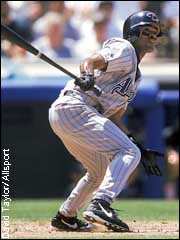 |
|
| | Wednesday, April 19 Arizona Diamondbacks | ||||||||||
| By Rob Neyer ESPN.com
Record: 100-62, 2nd overall Payroll: $70.0 million, 9th overall Runs scored: 908, 1st in NL Runs allowed: 676, 3rd in NL What went right Just about everything. The new pitchers earned their enormous salaries, and the old hitters, so disappointing in 1998, exploded. New left fielder Luis Gonzalez enjoyed the season of his life, and rookie first baseman Erubiel Durazo batted better than .400 in the minors before making a big splash in the majors. What went wrong Ex-phenom Travis Lee lost his job to Durazo, and then he got hurt. The bullpen was shaky early on, but did well in the second half, thanks in large part to closer Matt Mantei. In retrospect, the critical decisions were: 1. Signing Randy Johnson. The Diamondbacks expected a lot, and they got the National League's eventual Cy Young winner as Johnson topped the league with a 2.48 ERA, 364 strikeouts and 272 innings. 2. Moving Jay Bell to second base. A shortstop in 1998, Bell didn't impress anyone with the glove, and his bat was something of a disappointment, too. At second base in 1999, he fielded well enough, and was arguably the most valuable player in the lineup. 3. The trade for Matt Mantei. The Diamondbacks suffered a series of demoralizing losses in April, as nobody seemed able to protect a late-innings lead. Mantei is one of the game's top young closers, and after he came aboard the D-Backs became a "normal" team, able to win the great majority of games in which they led late. Looking ahead to 2000 Three key questions 1. Have we now seen the real Matt Williams and Jay Bell? 2. Can Tony Womack really play shortstop? 3. Is the lineup too old to score anywhere near 900 runs again? Can expect to play better Travis Lee certainly can't play worse than he did in 1999, although he might end up as trade bait if he doesn't take well to right field, supposedly his new position. Erubiel Durazo's percentages aren't likely to improve, but his raw stats will benefit greatly from a full season with the Diamondbacks. He could finish with 30 homers and 100 RBI. Can expect to play worse Almost everybody else in the lineup.
SS Tony Womack 2B Jay Bell LF Luis Gonzalez 3B Matt Williams 1B Erubiel Durazo CF Steve Finley RF Travis Lee C Kelly Stinnett Rotation/closer Randy Johnson Todd Stottlemyre Omar Daal Armando Reynoso Brian Anderson Matt Mantei A closer look This is no revelation, but the Diamondbacks made a huge improvement in both the pitching and hitting departments last season. At least some of the pitching improvement was expected, what with the money the club spent to acquire Randy Johnson and Todd Stottlemyre. But the hitting? This is a club that, in 1998, ranked 14th in the National League in runs scored. And in response, the Diamondbacks did little in the off-season except add Luis Gonzalez, Steve Finley and Tony Womack, none of whom had been particularly productive the previous season. Nevertheless, in 1999 the Diamondbacks led the National League in scoring, with 908 runs, despite playing in a pretty good pitcher's park. Some commentators speculated that perhaps the Arizona hitting improved because the Arizona pitching improved. That is (so the argument went), with the pitchers doing so well, it took pressure off the hitters, who responded with great success facilitated by a new-found relaxation. Does this theory hold water? Relative to their league, the Diamondbacks' team ERA improved by 27 percent from 1998 to 1999. This is the seventh-best improvement by a major league team since 1970, and represents one of only 17 improvements of 20 or more percent over that same span. Did the hitters for those other 16 teams show a significant improvement in the year of the big pitching improvement? No, they did not. In fact, their performances were nearly identical in the two seasons.
AB OBP Slugging OPS
Year 1 60094 .325 .396 721
Year 2 57037 .326 .395 722
Like we said, nearly identical. In fact, if we didn't carry out the decimal points (not pictured here), the OPS (on-base percentage plus slugging percentage) for both seasons would be 721.
Of course, if we throw the Diamondbacks into the study, we would find a slight increase in batting stats in Year 2 ... but not enough to change our expectations for future teams that improve their pitching staffs from one year to the next. As much as the guys on TV like to talk about chemistry and psychology, it seems that the pitchers and the hitters operate, for the most part, independently of each other.
Rob Neyer is a staff writer at ESPN.com.
| ALSO SEE Diamondbacks minor-league report ESPN.com's Hot Stove Heaters  | ||||||||||

